
| Quantity | 3+ units | 10+ units | 30+ units | 50+ units | More |
|---|---|---|---|---|---|
| Price /Unit | $610.37 | $597.92 | $579.23 | $554.32 | Contact US |
 HAE16C Single Harmonic Equatorial Mount Type-C Support Equatorial/Horizontal Dual Mode with 8.2KG Load Capacity
$1,141.05
HAE16C Single Harmonic Equatorial Mount Type-C Support Equatorial/Horizontal Dual Mode with 8.2KG Load Capacity
$1,141.05
 IEAF Portable High Precision Electric Automatic Focuser Built-in Temperature Sensor for iOptron Telescope
$159.03
IEAF Portable High Precision Electric Automatic Focuser Built-in Temperature Sensor for iOptron Telescope
$159.03
 ANTLIA 8-inch 8EL UHC PRO Visual Enhancer Filter Light Damage Filter for Astronomical Telescope
$133.36
ANTLIA 8-inch 8EL UHC PRO Visual Enhancer Filter Light Damage Filter for Astronomical Telescope
$133.36
Player One Apollo-M MAX IMX432 1.7MP Solar Mono Camera Astronomical Camera 256M DDR3 (with ACS)
Focus on Solar Imaging!
Apollo series is the world's first camera line specifically designed for solar photography. This series is named after Apollo.
The Apollo series features sensors for Sony with global shutters and a focus on monochrome sensors.
We have launched 4 models of Apollo cameras:
Apollo-M MAX (IMX432) monochrome camera with a 1.1" sensor.
Apollo-M MINI (IMX429) monochrome camera with a 2/3" sensor.
Apollo-M (IMX174) monochrome camera with a 1/1.2" sensor.
Apollo-C (IMX174) color camera with a 1/1.2" sensor.
*
Note: The solar camera needs to be used with a device such as baader
film or Herschel wedge prism for energy cut-off or light reduction. Do
not use the camera directly on a telescope without a dimming device.
Product Description:
Apollo-M
MAX is a solar camera developed by Player One Astronomy. It adopts the
IMX432 1.1" format monochrome sensor for Sony. The 9um pixel size
accommodates a well depth of 100ke with a total of 1.7MP (the resolution
is 1608*1104), and the diagonal is 17.5mm.
Pregius Technology
Apollo-M
MAX (IMX432) is based on Pregius 3rd Generation. But IMX432 is quite
different. According to the introduction of technical documents, pixel
size of 3rd Gen usually is 4.5um, and full well is 25Ke. But this sensor
has 9um pixel, and of course the full well is up to 4x (100Ke).
Format
Apollo-M MAX (IMX432) has 1.1" format. It is pretty big. The area is almost twice that of the IMX174.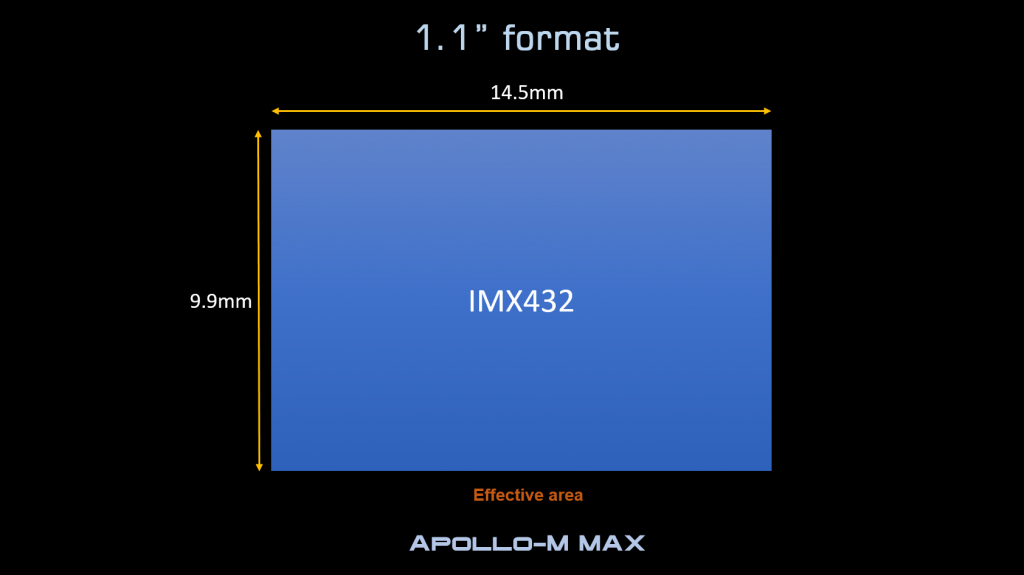
Pixel Size
9um
pixel is 1.5 times the size of the IMX174 pixel, which shows that it is
more suitable for long focal length and telephoto ratio shooting, such
as the combination of SCT + filter (with 4.2X) for Daystar.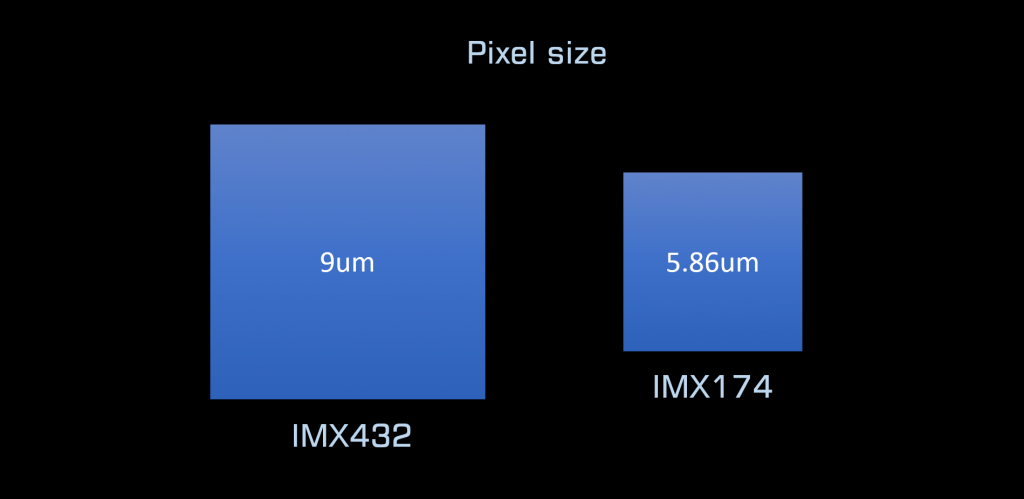
Full Well Charge
This
camera has a 100Ke full well, which is more than three times that of
IMX174. The super-large full well provides greater tolerance, which is
very advantageous in astronomical photography, such as when we want to
photograph the sun's surface and the dark edge of the prominence at the
same time, or when we want to photograph the dark side and the bright
side of the moon at the same time.
HCG Mode and Readout Noise
The
HCG mode will be automatically turned on when the gain is > 145. The
readout noise will be instantly reduced to 4.6e, and the dynamic range
will be extended to 12drops.
At 380 gain, the IMX432 has a
readout noise of 2.6e which is much lower than that of the IMX174. At
this time, the full-well charge is still much larger than that of the
IMX174.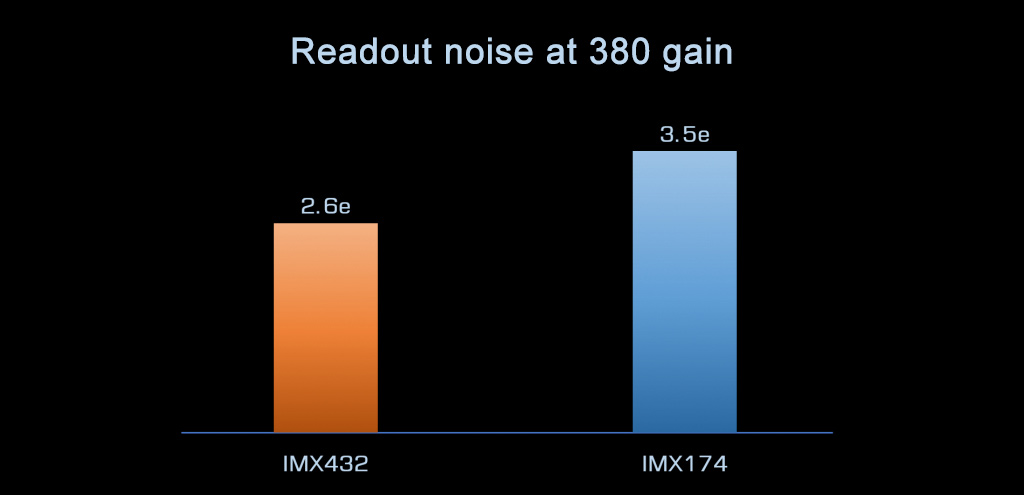
Highlights:
New Solar Ha imaging and post-processing tutorial (Demonstrate with Apollo-M MAX)
https://player-one-astronomy.com/solar-imaging-and-processing-tutorial-demonstrate-with-apollo-m-max/
No Banding
Row
noise problem is a big trouble in solar imaging. When we use IMX174 or
IMX178 cameras, banding occurs sometimes. Although we can make it slight
in post-processing, but it still does negative affects on the details.
The
biggest surprise in testing Apollo-M MAX is that we found that images
of IMX432 are so smooth, no annoying horizontal banding. So that, we can
focus on collect details in any focal ratio, in any way (full disk
mosaic or ROI). Never need to worry about banding issue in
post-processing.
With a global shutter, Apollo-M MAX is very suitable for sun and space station imaging.
"The official recommended camera of The Charlie Bates Solar Astronomy Project"
Recommended Accessories:
Optional ACS (Active Cooling System)
ACS
is an external air-cooled system. It is designed for solar and big
format planetary cameras with PCS (Passive Cooling System). ACS can
provide much better temperature control. When your camera has PCS + ACS,
its temperature is only 7℃ higher than the ambient temperature. The
camera body is a little warm, but it is not hot! ACS can be used in
daylight for solar imaging and used at night for DSO lucky imaging.
User Reference Images:
The Sun in White Light
For better contrast, Player One Photosphere 10nm filter will be a good choice.

Apollo-M MAX with SW150APO, photo by Simon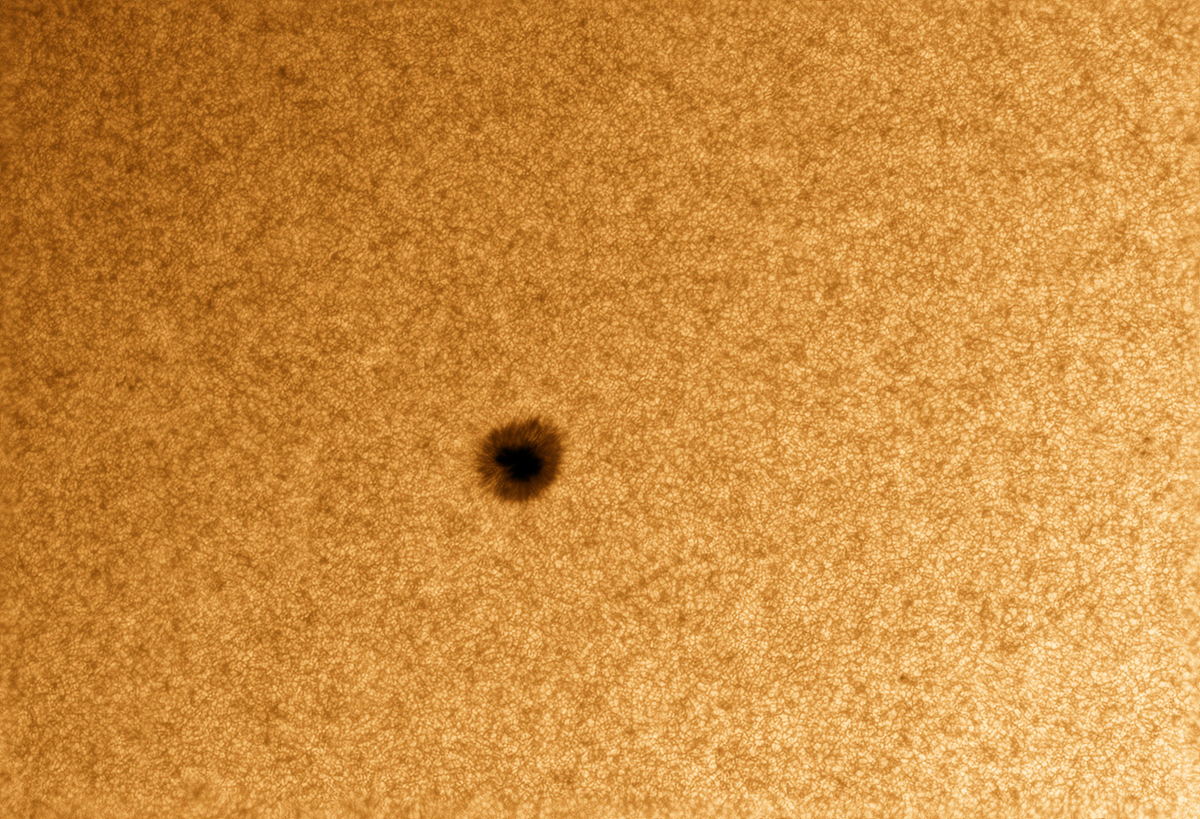
Apollo-M MAX with SW150APO, photo by Simon
Demonstrate with ES127APO: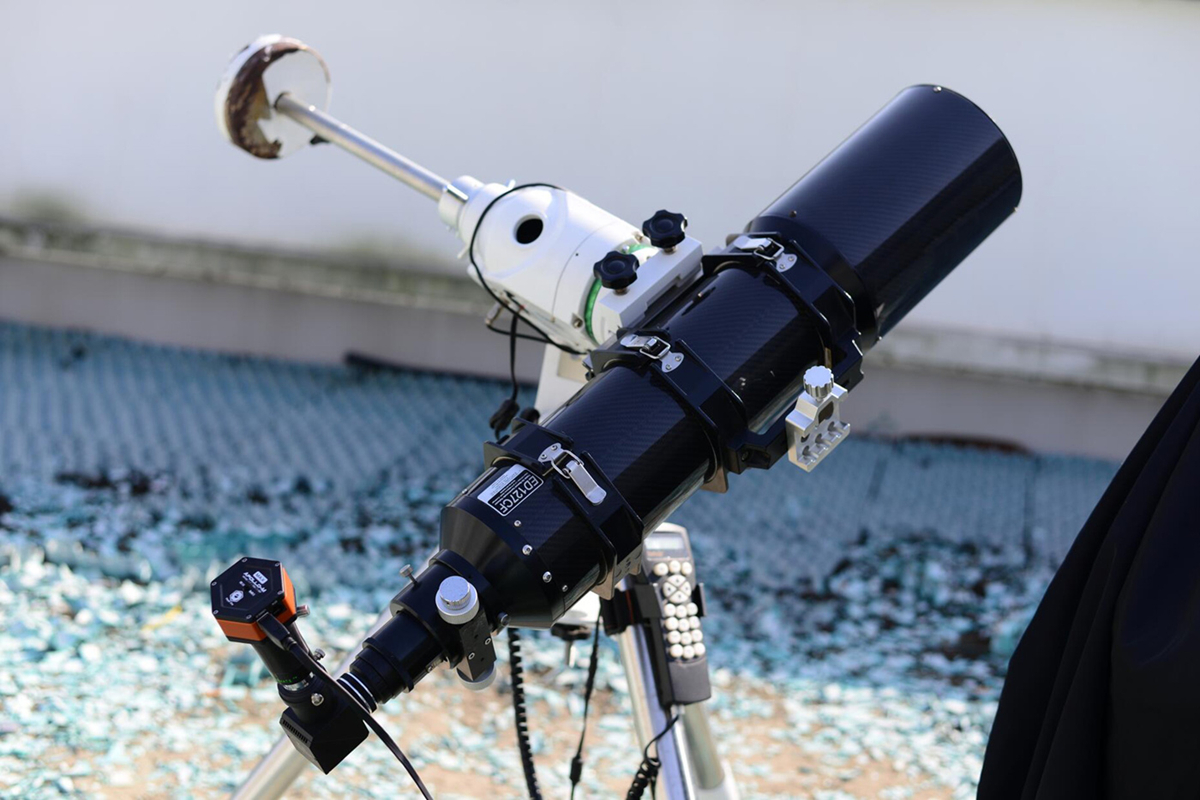
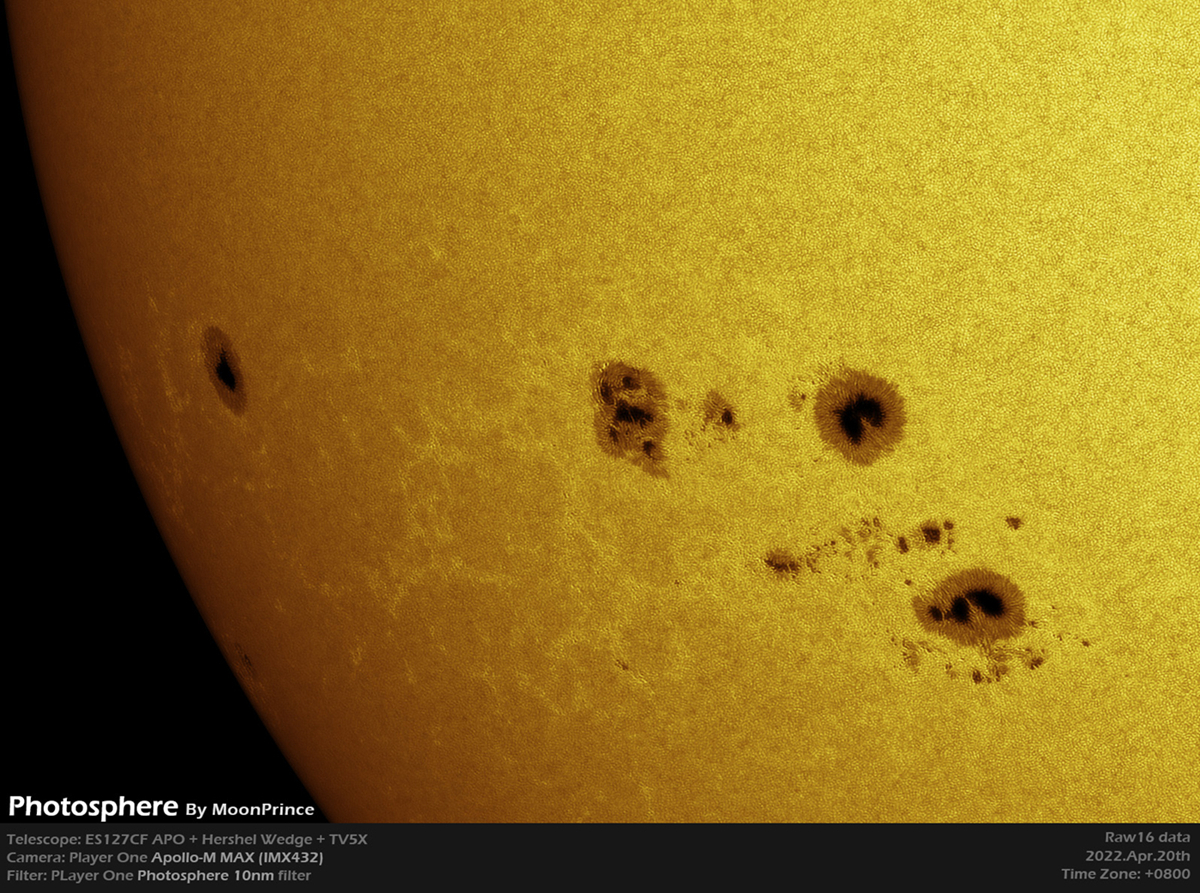
The Chromosphere in H-Alpha
Introduce new 1.25" ERF filter for Quark Chromosphere (Ha version), to reject energy and extend life span of your Quark.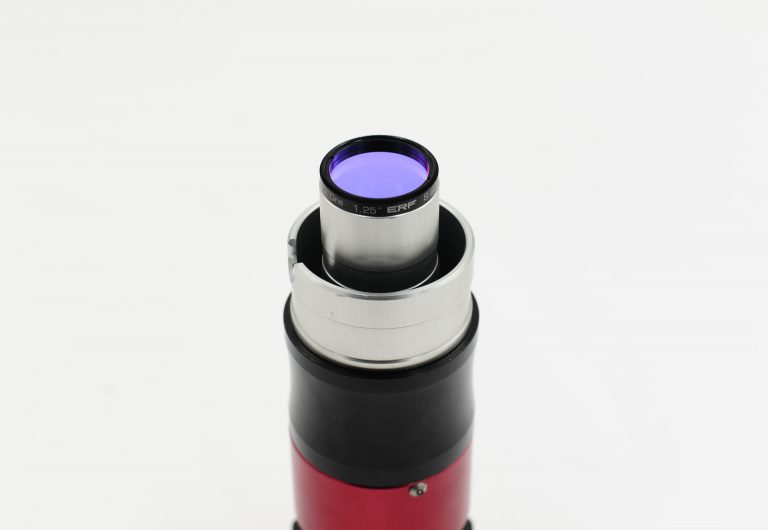
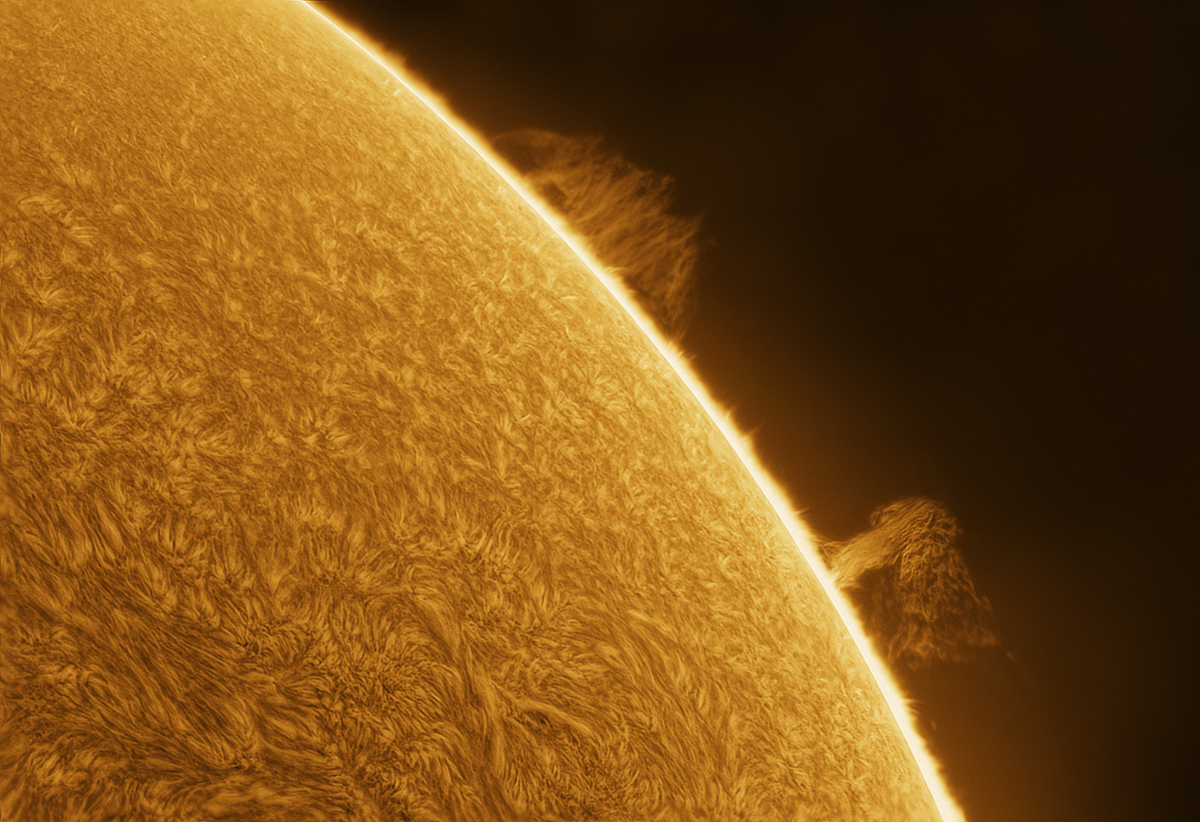
Apollo-M MAX with SW150APO + for QUARK Chromosphere, photo by Simon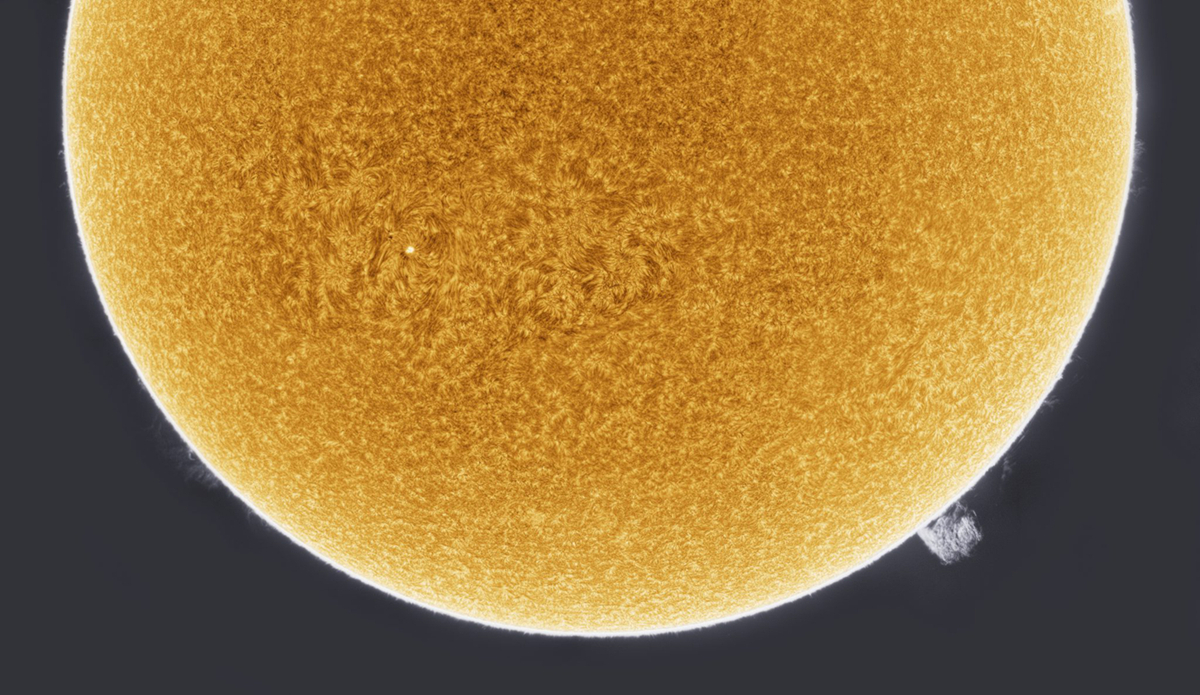
Apollo-M MAX with SW150APO + for QUARK Chromosphere, photo by Simon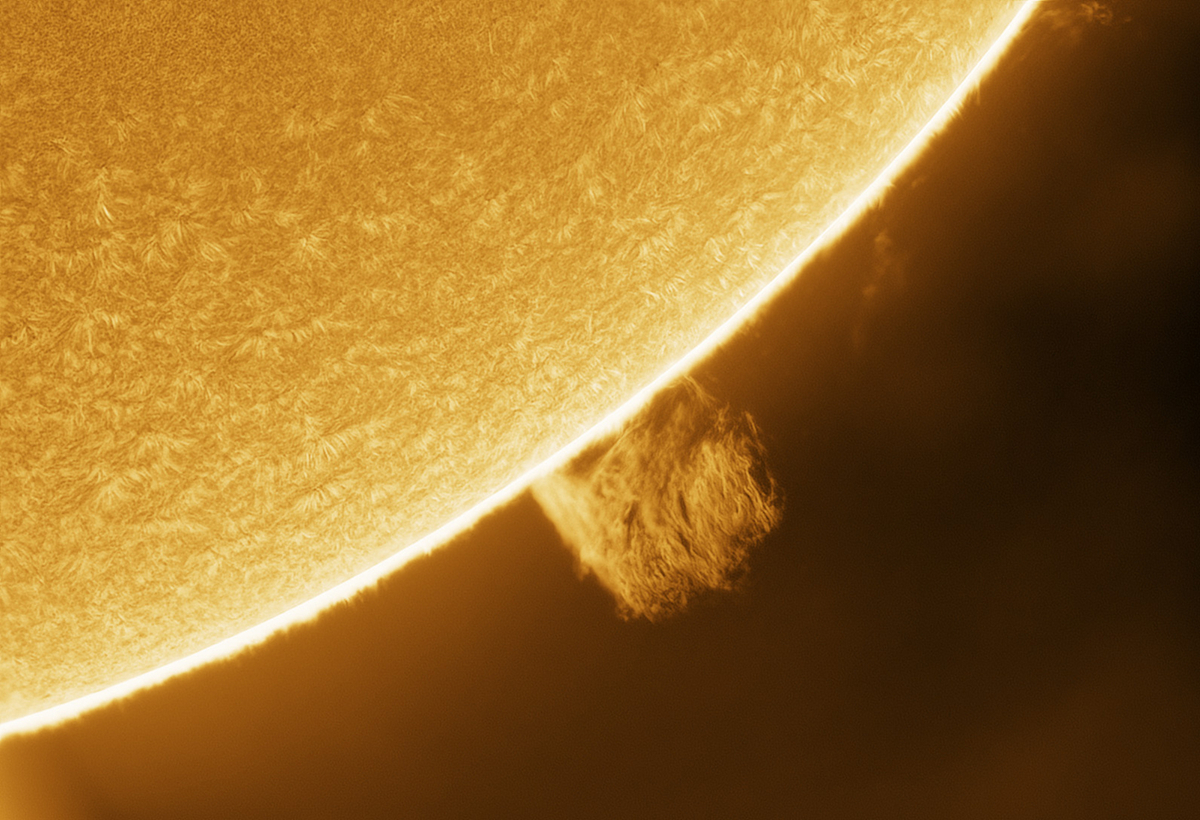
Apollo-M MAX with SW150APO + for QUARK Chromosphere, photo by Simon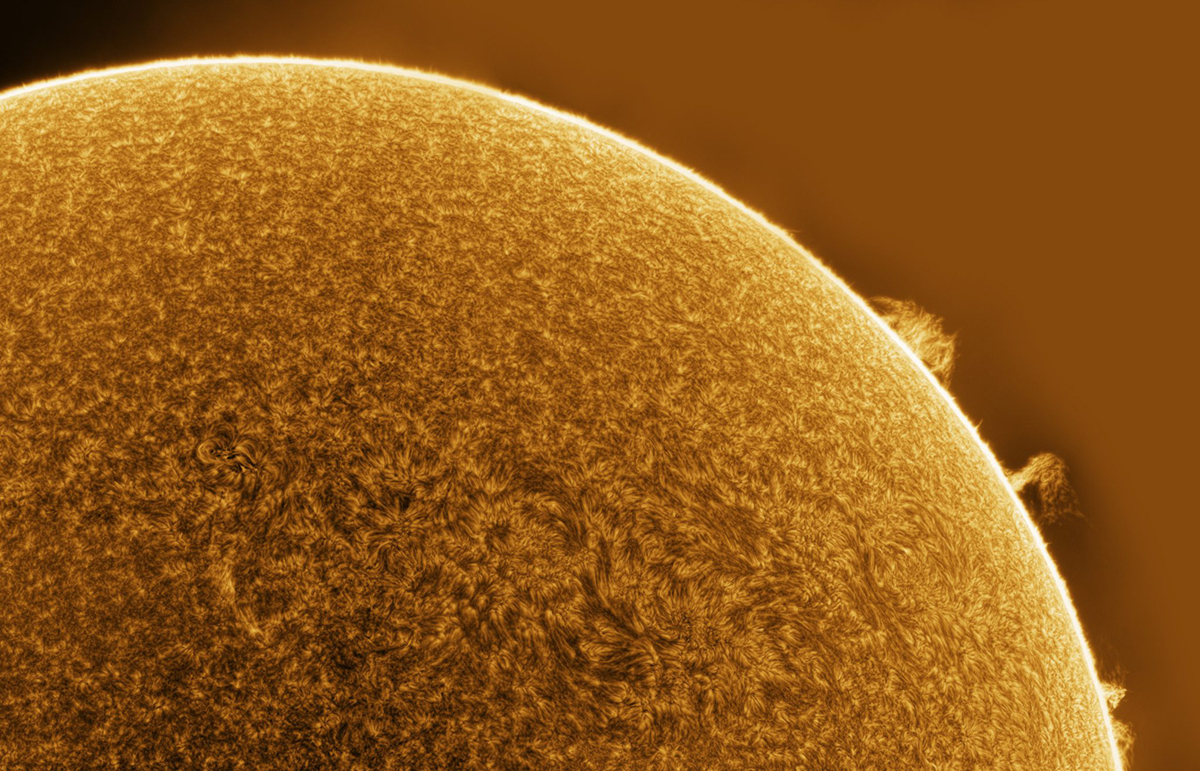
Apollo-M MAX with SW150APO + for QUARK Chromosphere, photo by Simon
Demonstrate with 80APO + for Quark Chromosphere:
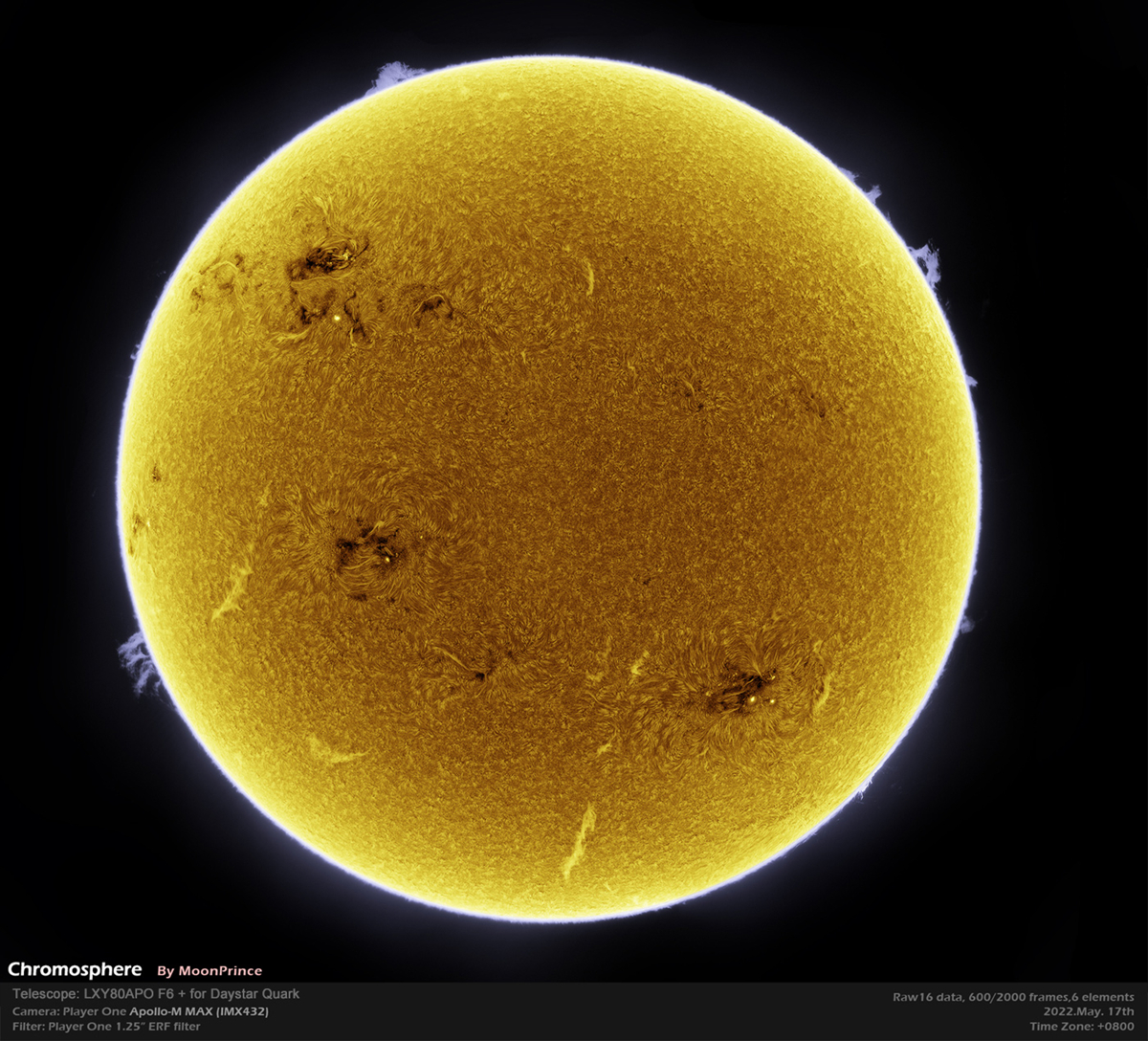
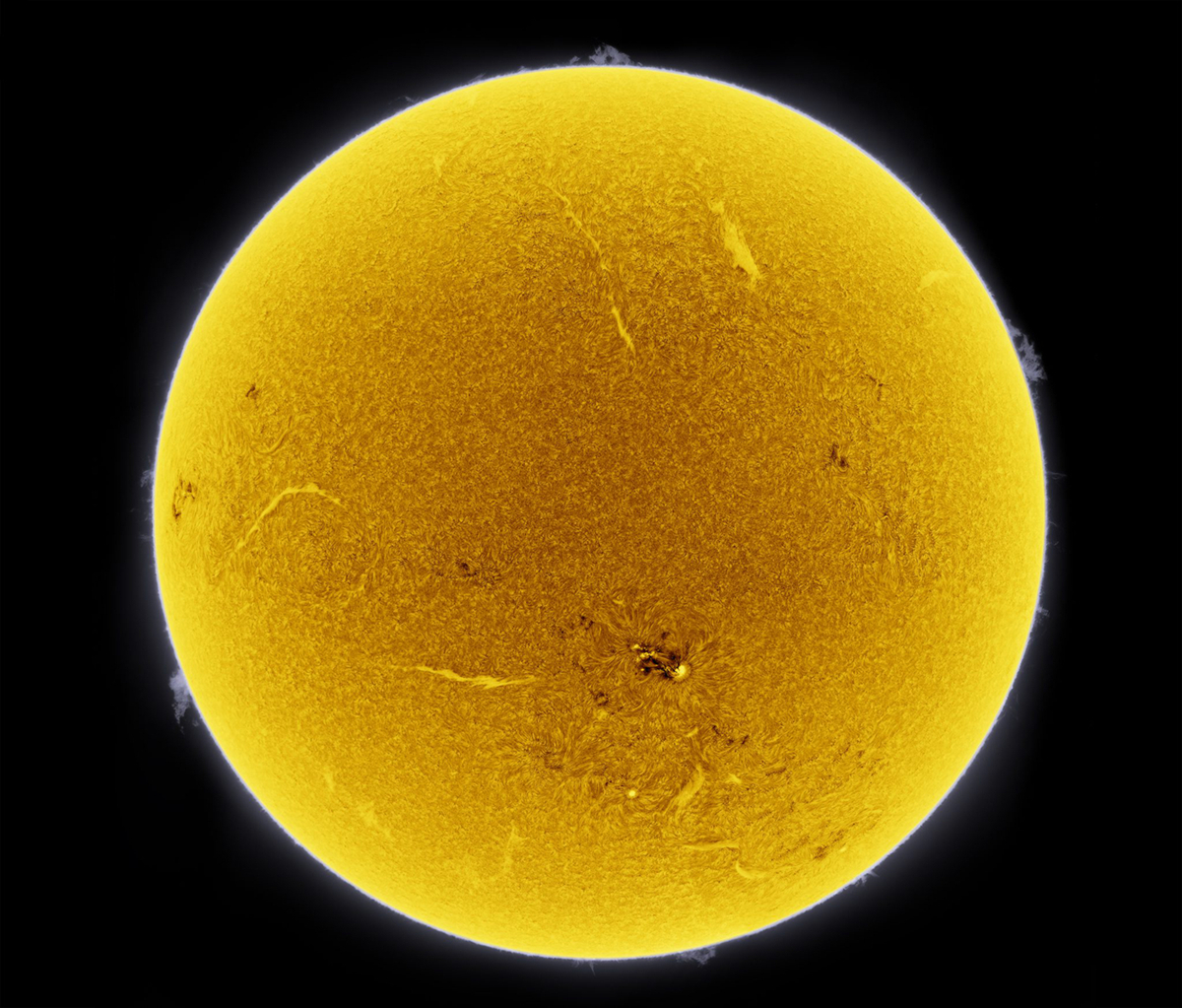
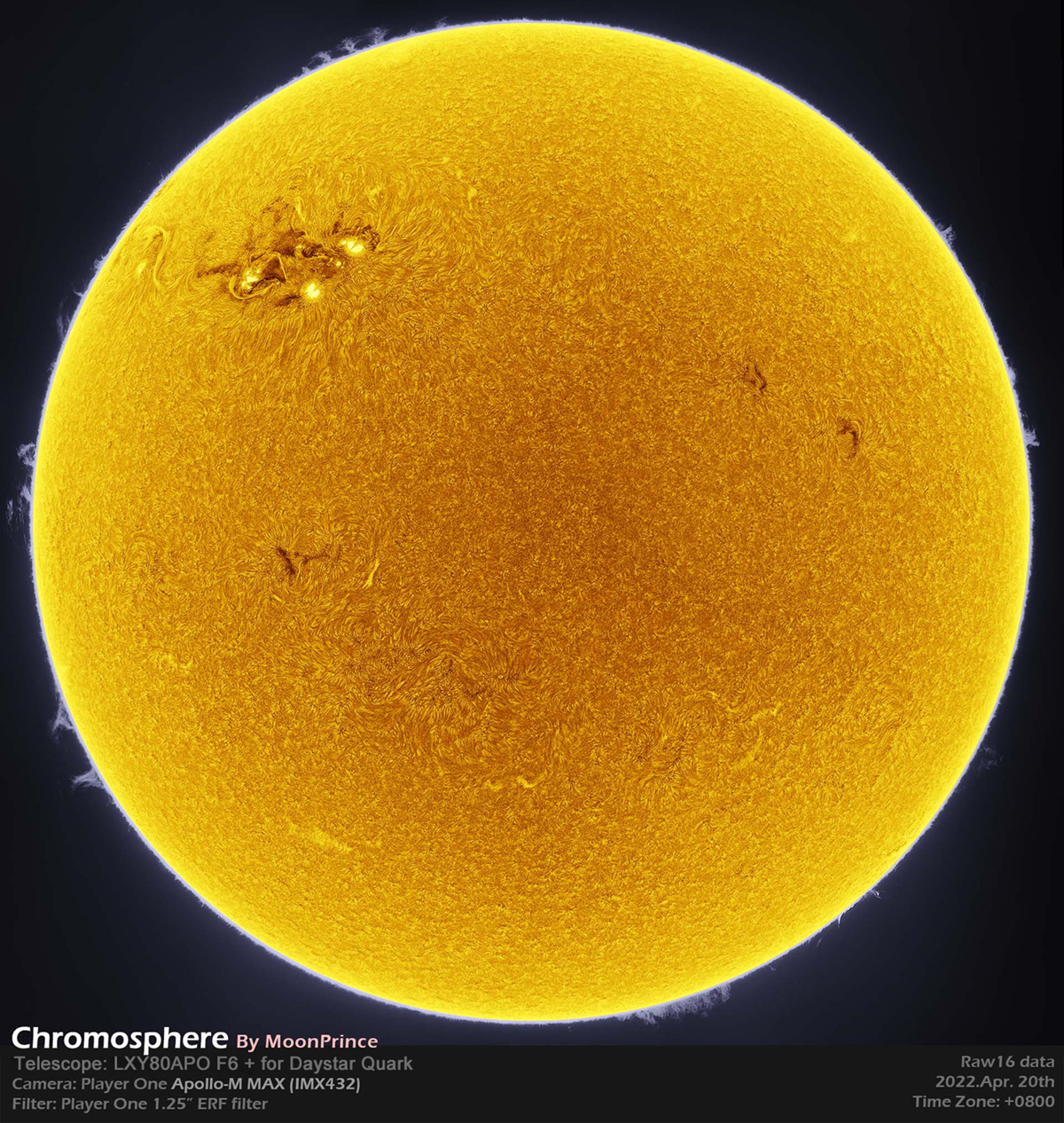
Demonstrate with ES127APO + for Quark Chromosphere: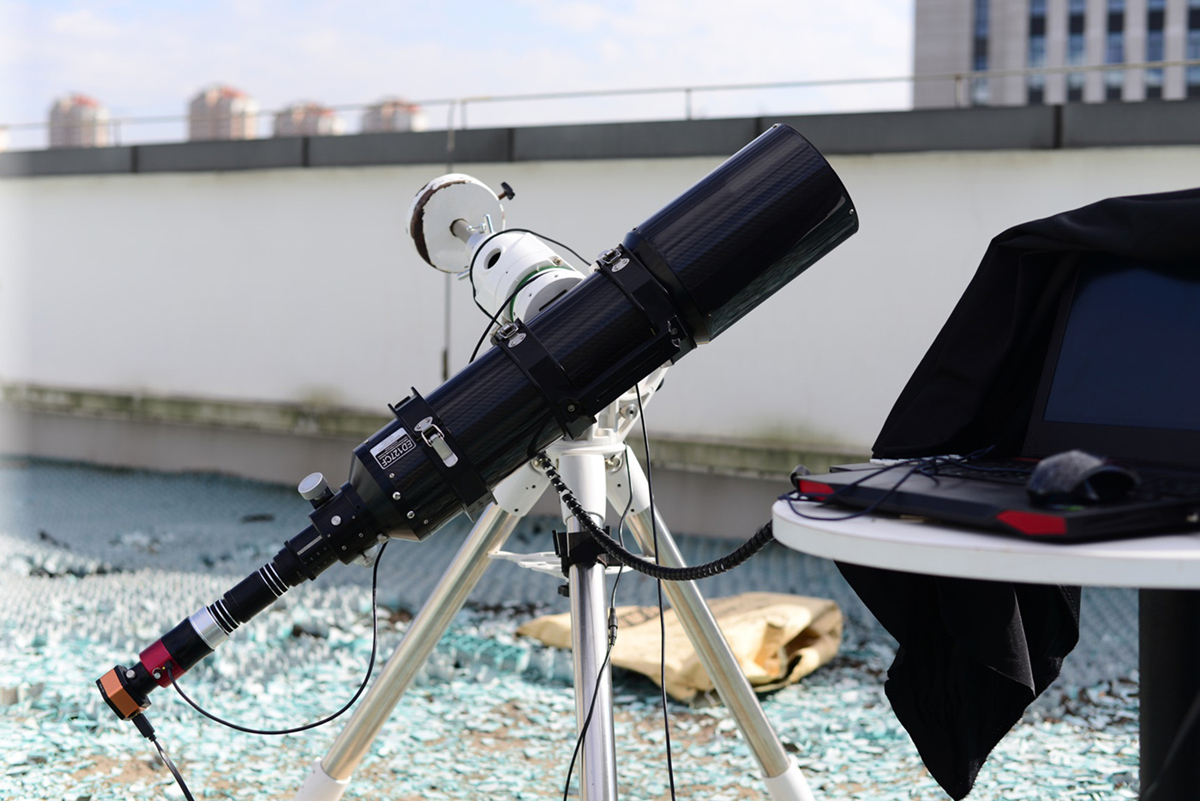


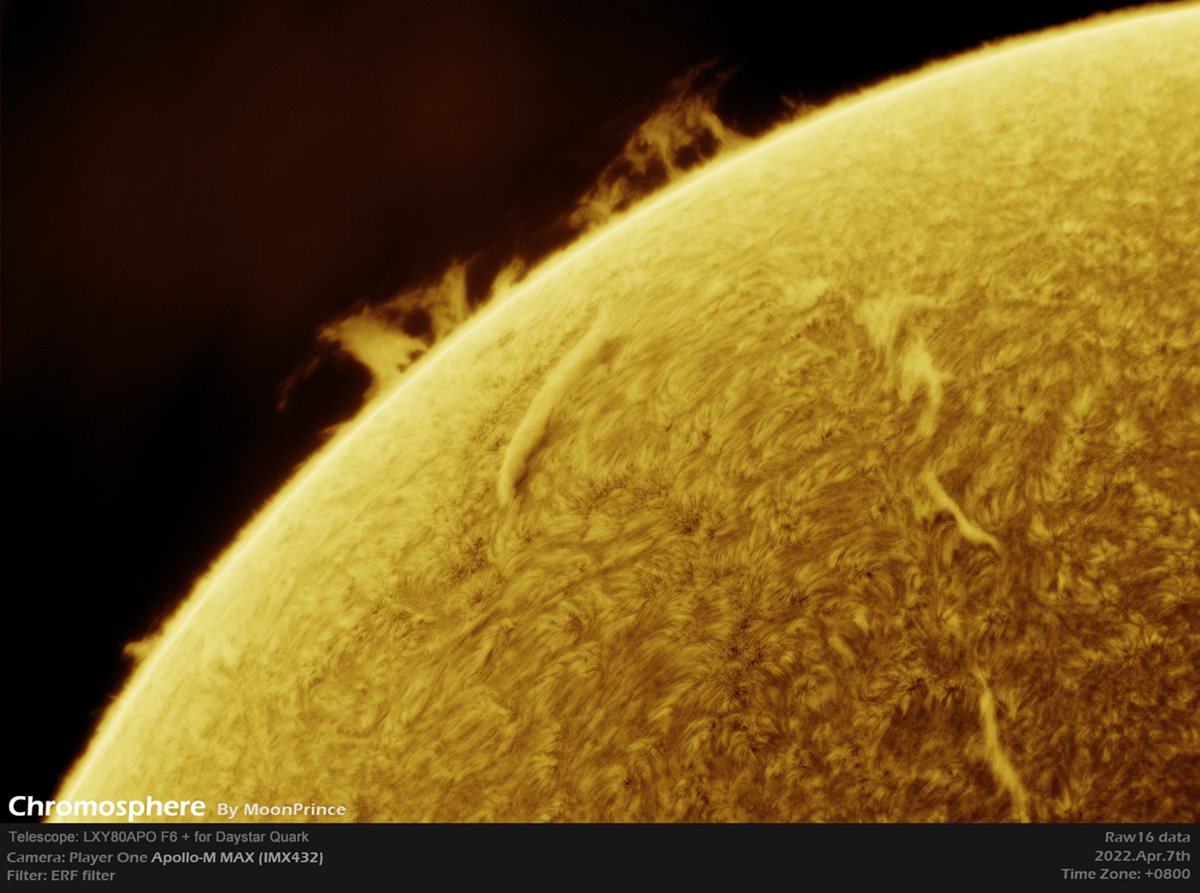

The Preminence in H-Alpha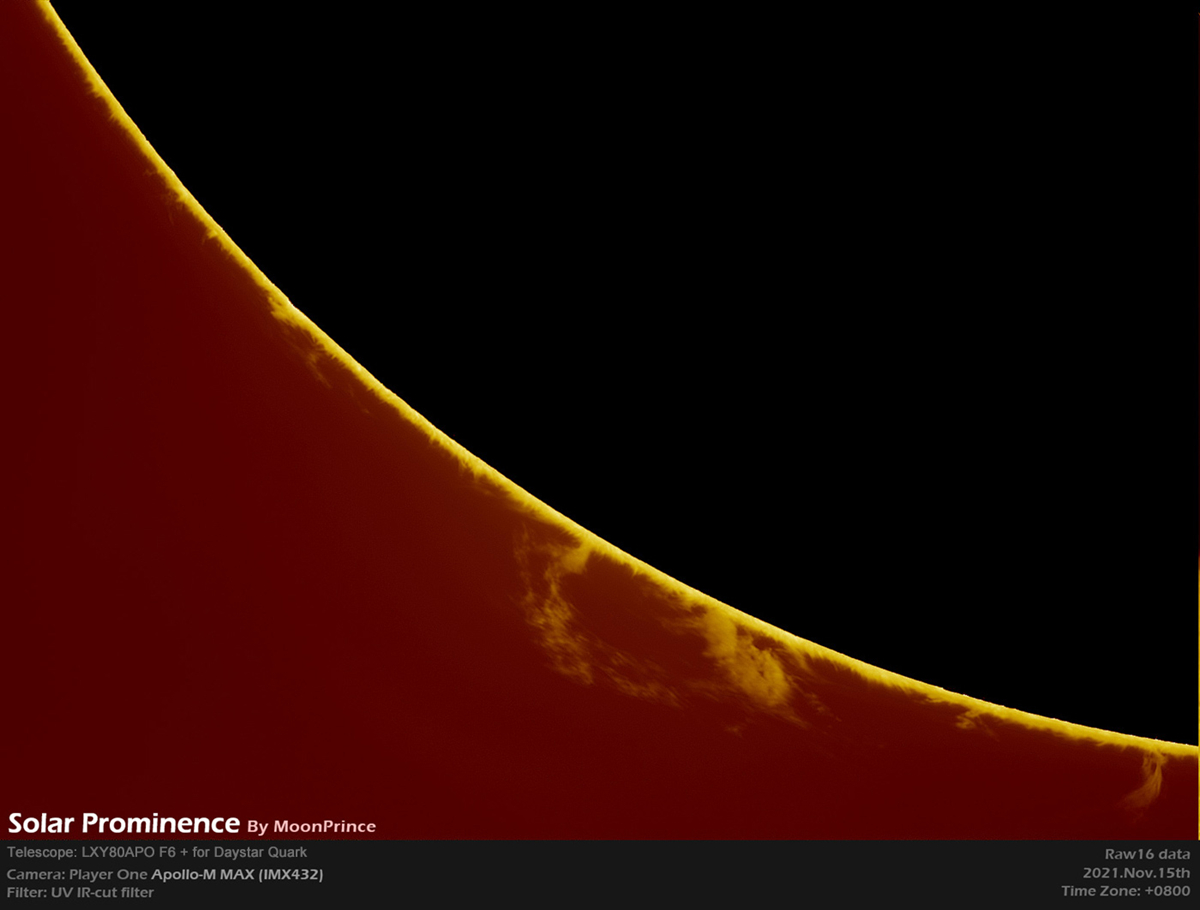
The Sun in CaK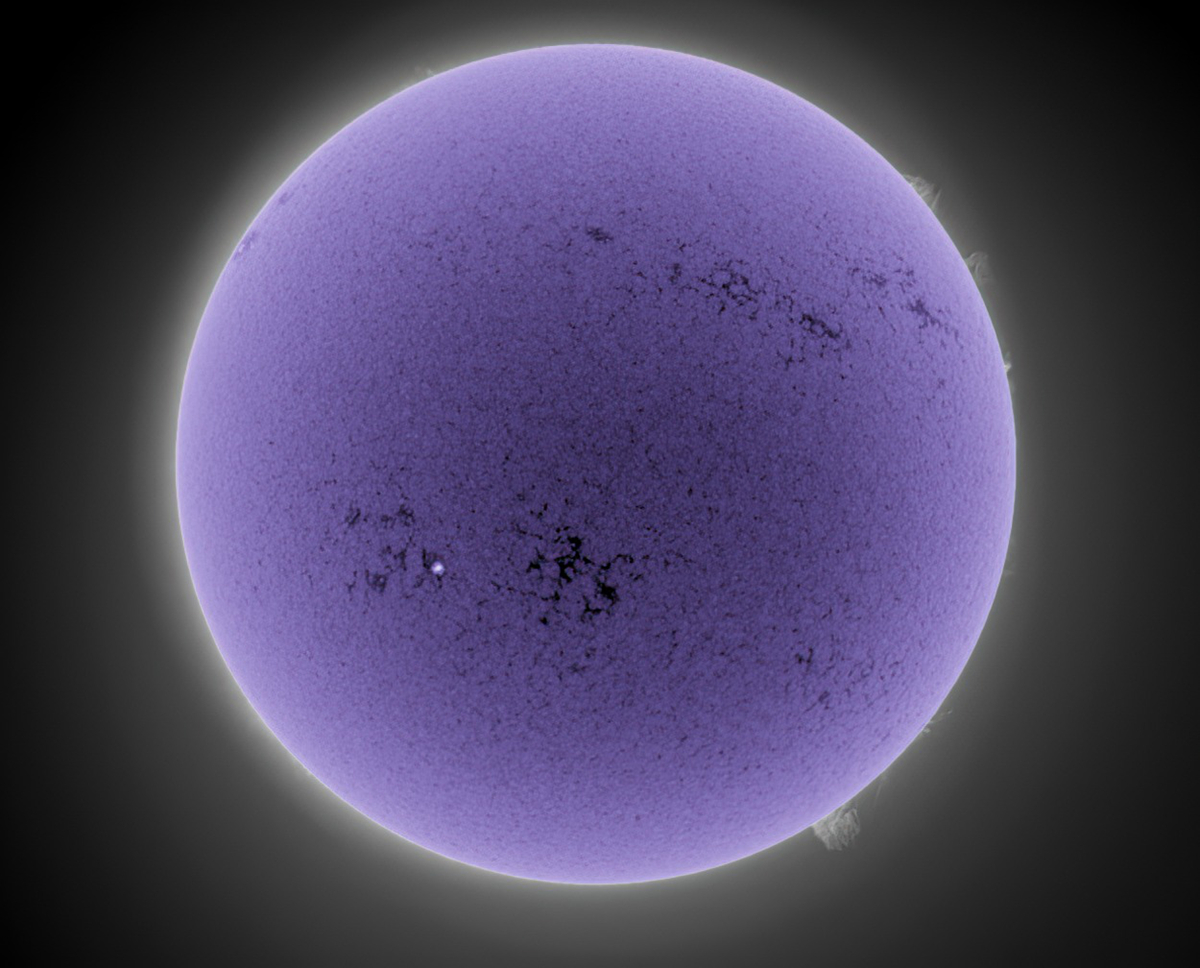
Lunt 152 + Calcium K module + Apollo-M MAX, Photo by Stephen W. Ramsden
Features:
The
naming of Player One Astronomy cameras is unique. Solar camera line is
named after Apollo, the god of the sun. The suffix of the name describes
the camera's biggest feature.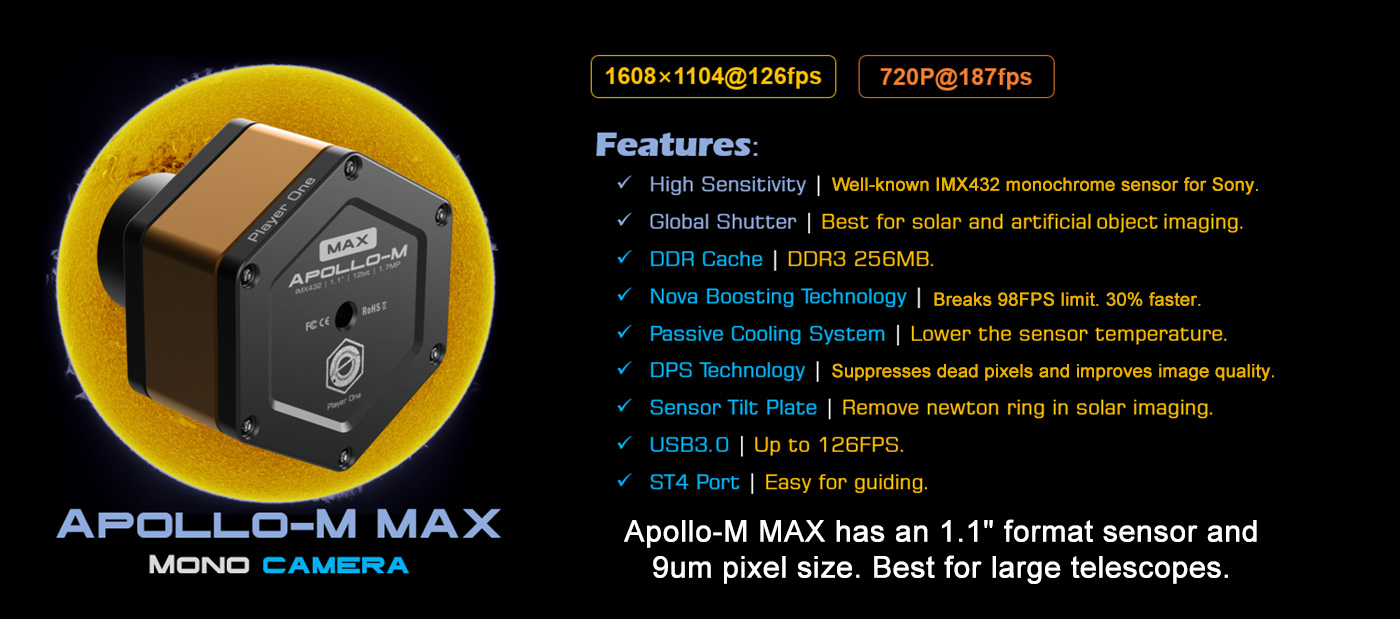
Download drivers and software: http://player-one-astronomy.com/service/software/
Download manuals: http://player-one-astronomy.com/service/manuals/
Cutting-edge Design
The
planetary cameras developed by Player One Astronomy use a scientific
and technological regular hexagon to construct the main body line,
supplemented by round chamfers to achieve both rigidity and flexibility.
The positive orange, which is imply solar, is matched with the low-key
and steady black. And the super-fine frosting process on the entire
surface makes the camera look luxurious and cool, highlighting the style
of high-end players.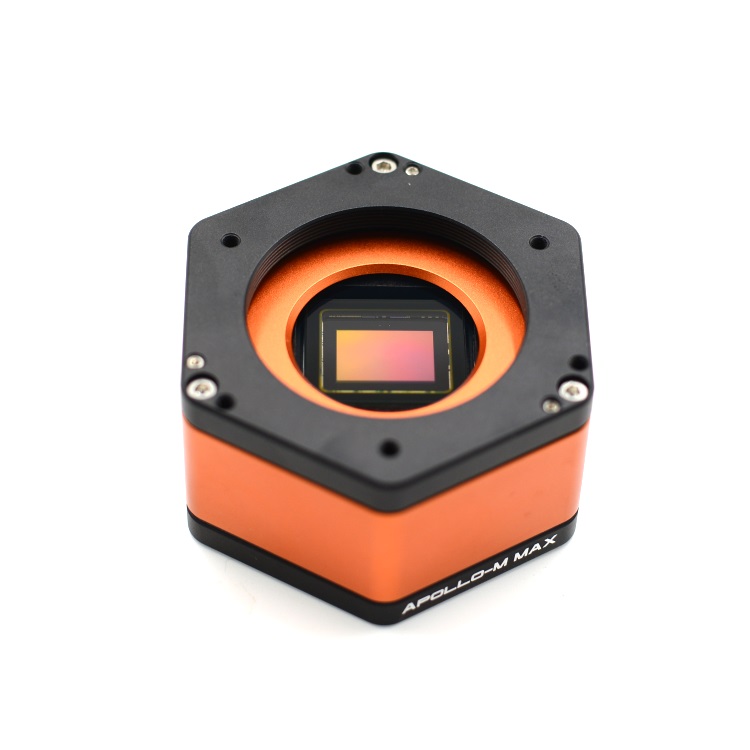
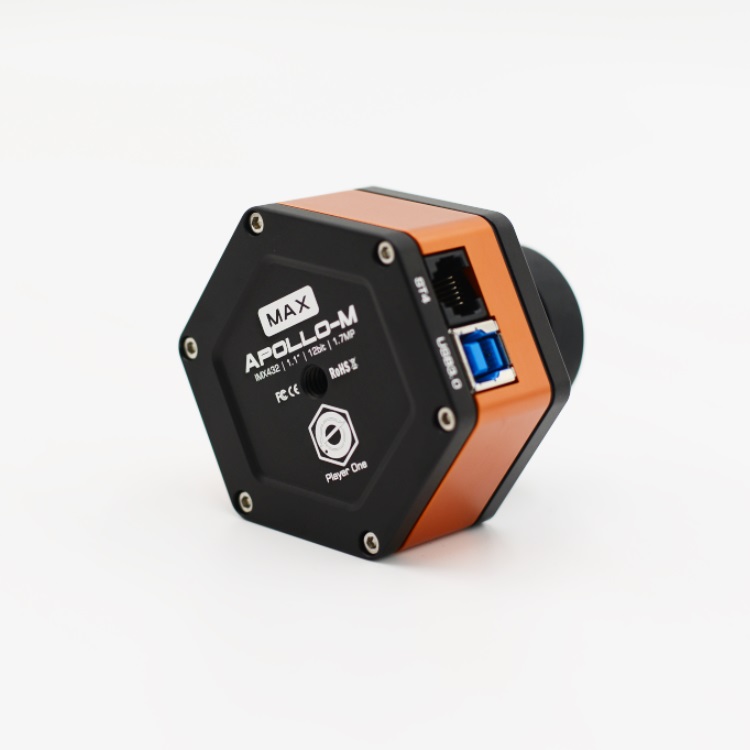
2nd Gen - Sensor Tilt Plate
When
you are taking photographs of the sun with a prominence telescope, the
Newton ring will be annoying. Smoother solar images without Newton ring
could be taken by adjusting the focal plate. Get a much smaller field
curvature of the telescope.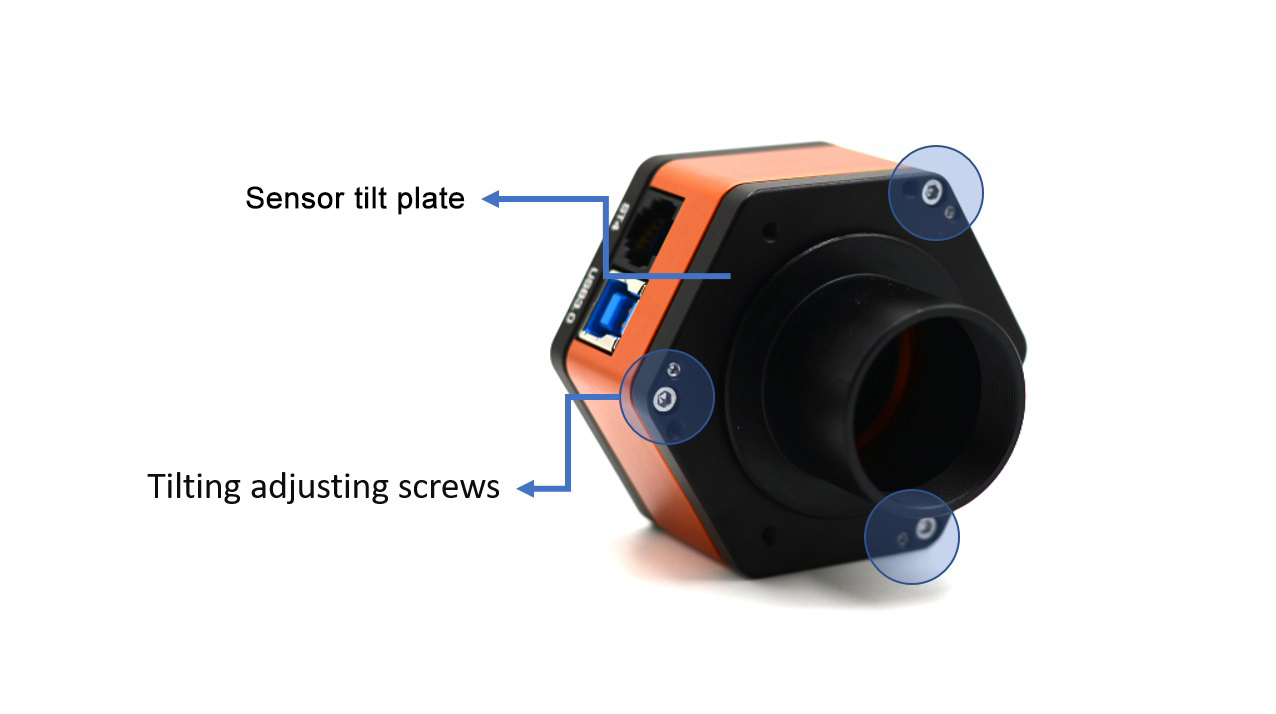
Built-in high-density sponge shading pad can block the light from the side slits without any side leakage.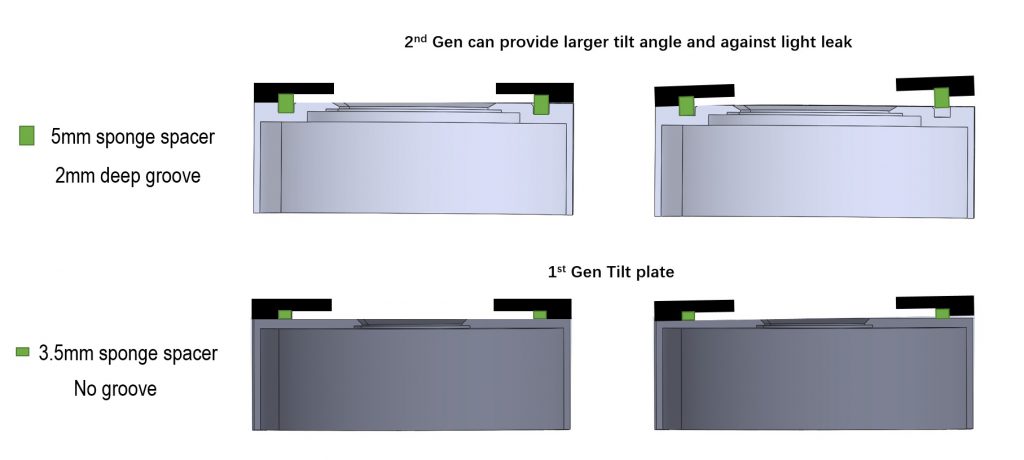

Passive Cooling System
When
solar cameras are working in daylight, their temperature will be much
higher than the temperature at night. Heat of global shutter sensors
will be a problem, especially for some big formats like IMX432. Player
One adds one new feature called Passive Cooling System to conduct the
heat from the sensor out.
256M DDR3 Cache
Player
One Astronomy cameras are the first one of planetary cameras to use the
DDR3 cache in the world! It helps stabilize and secure data
transmission, effectively avoids frame dropping and greatly reduces read
noise.
With the DDR3 cache, the cameras do not have high demands on computing any longer. But the cameras still have an excellent performance even if they are connected to a USB 2.0 port.
DPS Technology
The
planetary cameras from Player One Astronomy have DPS (Dead Pixel
Suppression) technology. The DPS can analyze many dark frames to find
out those fixed abnormal pixels and record the map in camera memory. In
imaging, each exposure frame and those positions of dead pixels will be
given a median value according to the active pixels around the abnormal
pixels.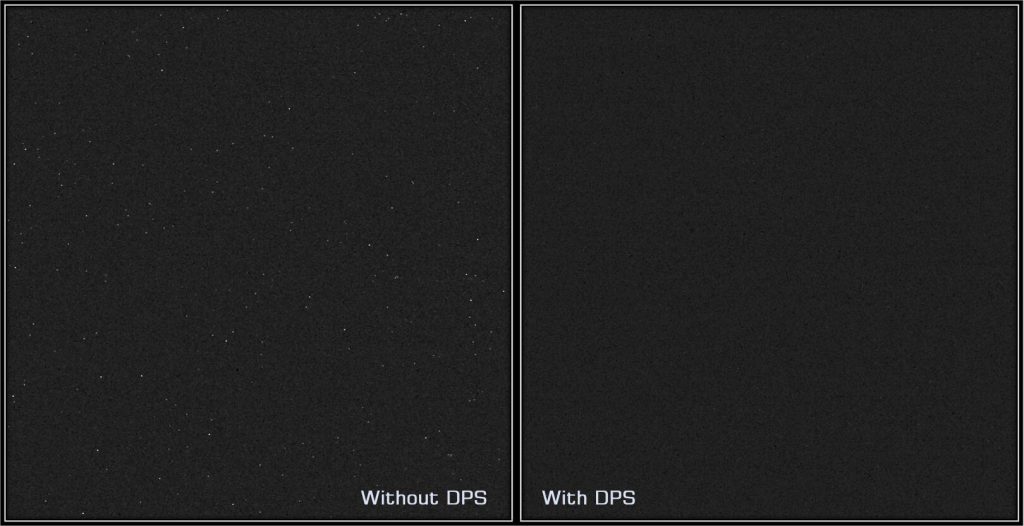
Over-voltage and Over-current Protection Mechanisms
Player
One cameras ensure the safety of your camera and other equipment
through over-voltage and over-current protection mechanisms.
Data Port
When
the camera is connected to the USB3.0 interface and full-resolution
preview is used, it can reach 109FPS in 12bit (RAW16) and 126FPS 10bit
(RAW8) mode. For recording images, the actual writing speed will be
affected by the writing speed of the hard disk itself. When the hard
disk writing speed is slow, the recording may not reach the theoretical
speed. It is recommended that you use a high-quality solid state drive
to record data to give full play to the performance of the camera.
Use an ST4 guide cable to connect the camera and the AUTO GUIDE port of the equatorial mount to do guiding.
Performance:
Readout Noise
Regarding
readout noise, we solemnly promise that all values are obtained from
actual tests. You can use the software for Sharpcap 4 for testing. SC4
has a function called Sensor Analysis, providing a very simple way to
test readout noise.
We wrote a tutorial on website: https://player-one-astronomy.com/service/manuals/
After many rigorous readout noise tests, this camera can get a low readout noise of 2.6e at a gain of 380.
If you are interested in readout noise testing, you can try it by yourselves because it is very simple.
QE Curve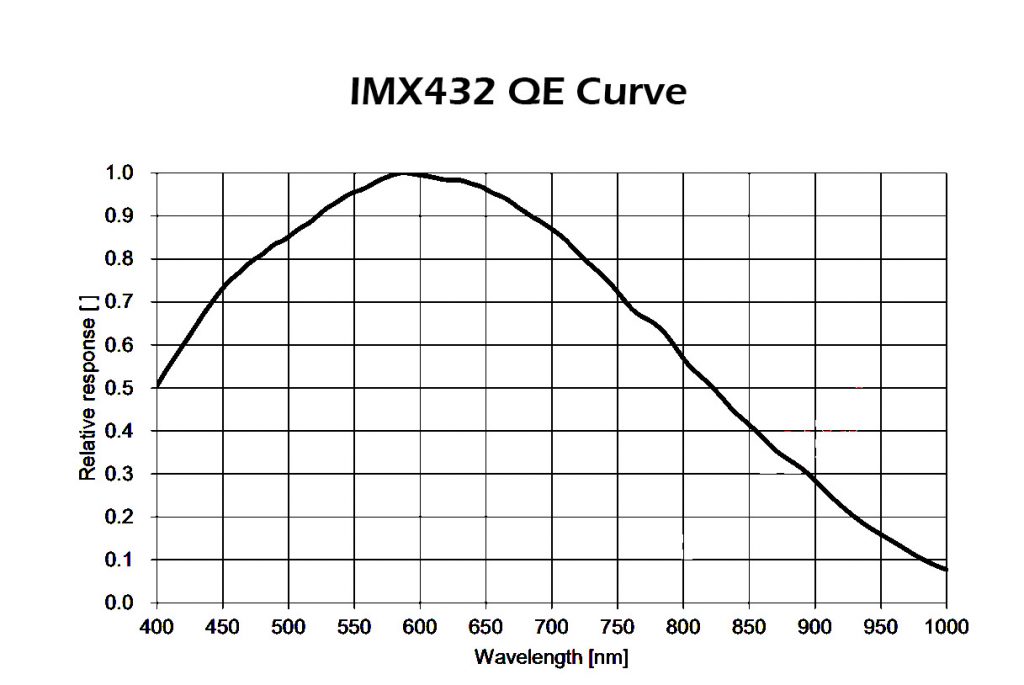
HCG Mode
The
Apollo-M MAX camera has a unique HCG mode which will automatically turn
on when the camera gain setting is >145. The HCG mode can greatly
reduce the readout noise and retain the same high dynamic range as the
low gain.
Mechanical Drawing: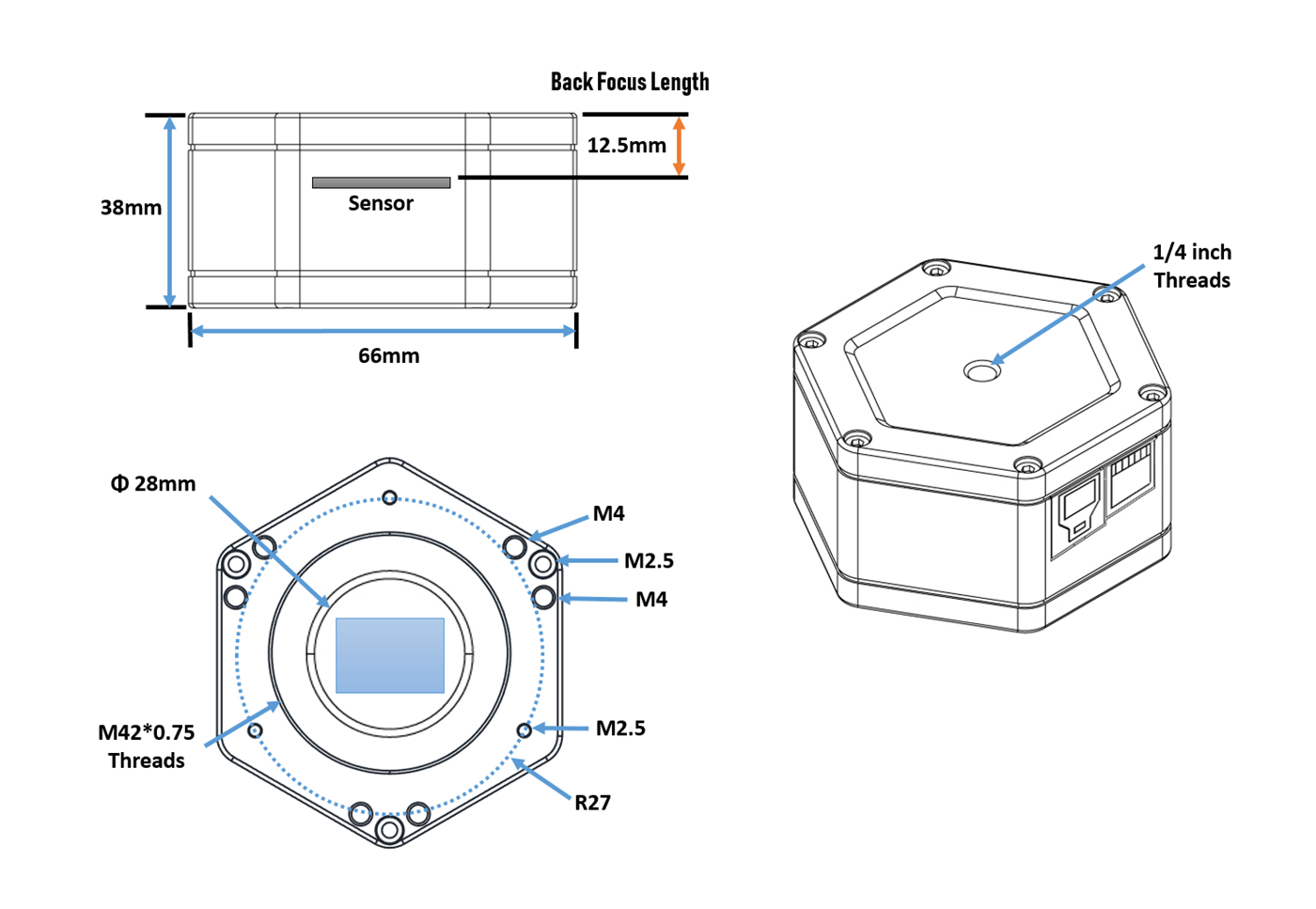
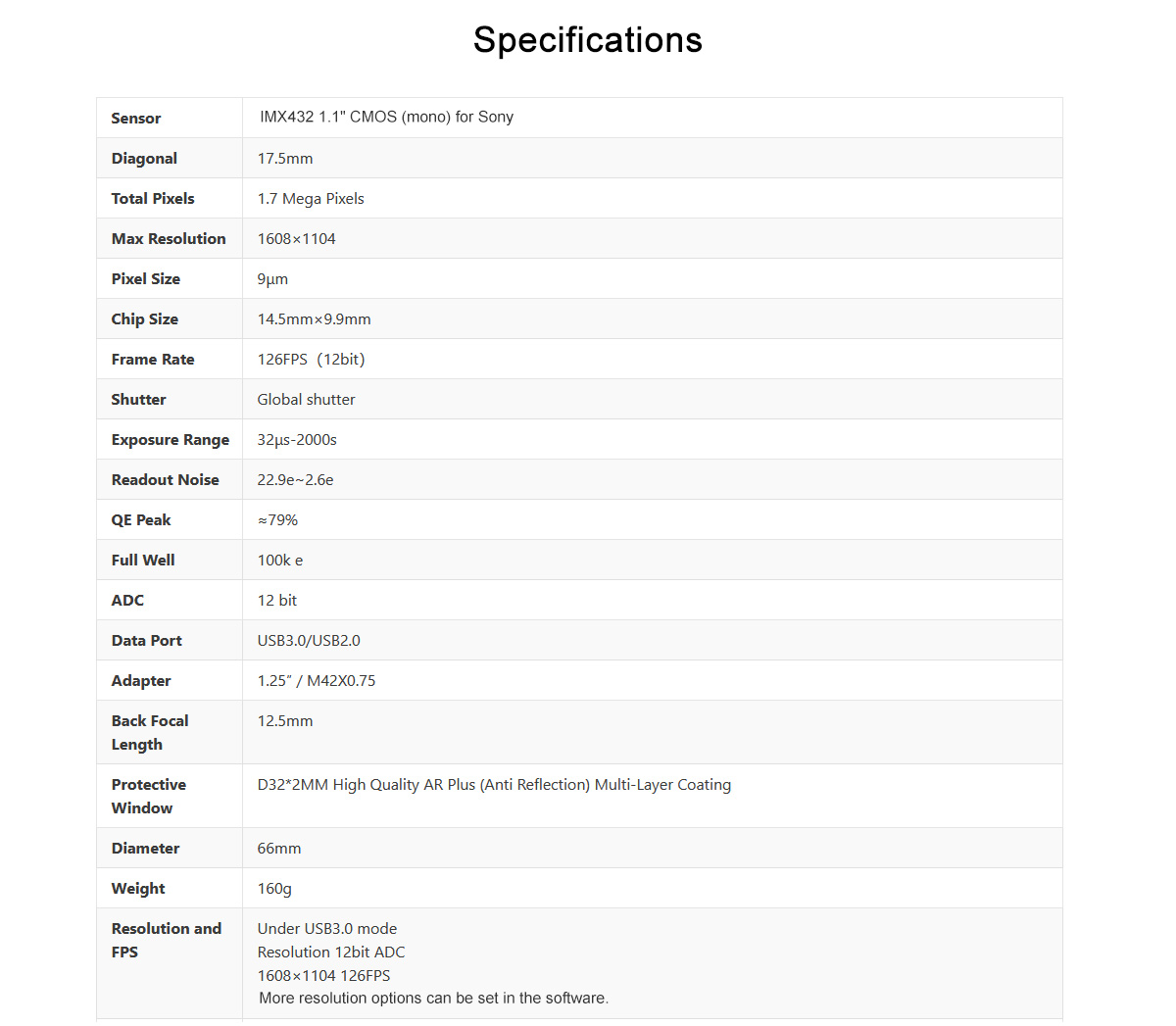
Package Included (with ACS):
- 1 x Camera and 1.25" T-mount
- 1 x 2M USB3.0 cable
- 1 x 2M ST4 cable
- 1 x 1.25" dust-proof cover
- 1 x Air blower
- 1 x M2 hex wrench
- 3 x M1.2 hex wrenches
- 1 x ACS (active cooling system)
Packaging Details (with ACS):
- G.W.: 1kg